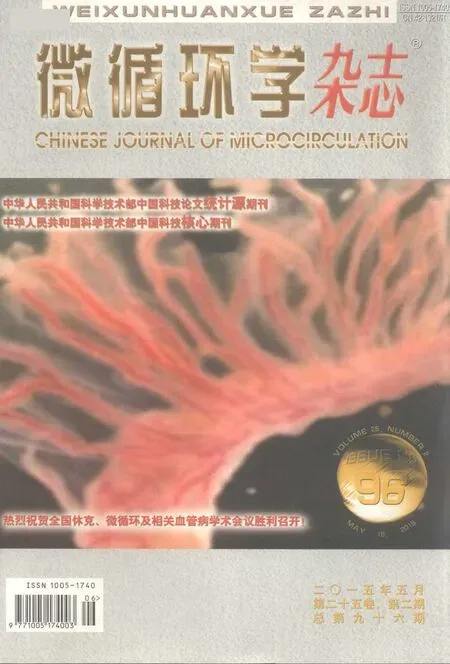罗布麻叶提取物预处理对缺血再灌注大鼠心肌损伤的作用*
屈小玲 王文清 梁向艳 铁 茹 刘芳娥 李 榕 张海锋,#
罗布麻叶提取物预处理对缺血再灌注大鼠心肌损伤的作用*
屈小玲1,2王文清3梁向艳1铁 茹1刘芳娥1李 榕4张海锋1,#
目的:观察罗布麻叶提取物(AVLE)预处理对心肌缺血再灌注(MI/R)大鼠心肌细胞凋亡和细胞信号转导系统中丝(苏)氨酸激酶(Akt)和细胞外信号调节激酶(ERK1/2)的影响。方法:采用SD大鼠MI/R模型(结扎冠脉左前降支起始部30min后再灌注4h),随机分为Sham组(假手术)、MI/R组、AVLE预处理组[AVLE (500mg/kg)灌胃,每日一次,连续灌胃7天后再行MI/R]。用TUNEL法检测各组心肌细胞凋亡,计算凋亡指数(AI);荧光免疫分析法检测各组心肌组织凋亡蛋白Caspase-3活性;Western Blotting测定心肌组织Akt和ERK1/2的表达水平和磷酸化水平。结果:与Sham组比较,MI/R组心肌细胞AI显著升高(P<0.05),心肌组织Caspase-3活性明显升高(P<0.05),心肌Akt和ERK1/2的磷酸化水平显著降低(P<0.05);与MI/R组比较,AVLE预处理组AI明显下降(P<0.05),心肌组织Caspase-3活性显著降低(P<0.05),Akt和ERK1/2磷酸化水平显著升高(P<0.05)。结论:AVLE能够抑制缺血再灌注所致心肌细胞损伤,其作用与生存信号通路蛋白PI3K/Akt和ERK1/2的活化水平有关。
罗布麻叶提取物;心肌缺血再灌注损伤;丝(苏)氨酸激酶;细胞外信号调节激酶;大鼠

1 材料与方法
1.1 实验动物、药物和主要试剂
健康6周龄清洁级雄性SD大鼠(体重200-220g),由第四军医大学动物中心提供。自制AVLE提取物:取干燥罗布麻叶(由第四军医大学药物研究所提供)100g浸泡于60ml 70%乙醇1h,连续两次后,提取上层蒸发至干(28g)。取13.5g提取物溶解于200ml蒸馏水中,用硫酸调整pH值为3.0后,采用Diaion HP20层析柱(3.6cm i.d.×18cm;美国Sigma-Aldrich公司)过滤。滤过液用200ml超净水和200ml 70%乙醇按常规方法洗脱。收集含水乙醇,蒸发至干,得到AVLE粉剂4.2g,用生理盐水配制为5%溶液。心肌细胞凋亡检测试剂盒购自德国Roche公司(批号:10770900);Caspase-3试剂盒购自美国Abcam公司(批号:GR182122);总Akt(tAkt)、磷酸化Akt(p-Akt)、总ERK1/2(tERK1/2)和磷酸化ERK1/2(p-ERK1/2)检测试剂均购自美国Cell Signaling公司。
1.2 实验分组处理和MI/R
54只SD大鼠适应性饲养2周之后,用随机数字表法分为:假手术组(Sham组);MI/R组;AVLE预处理组;每组18只。根据文献[10,11],AVLE预处理组给予5%AVLE溶液(500mg/kg)每天灌胃1次,连续7天后行假手术或复制MI/R模型。另两组给予等量蒸馏水灌胃,7天后行假手术处理或复制MI/R模型。
7天后大鼠禁食过夜,以2%戊巴比妥钠(60mg/kg)腹膜内注射麻醉,按参考文献[12]复制MI/R模型:大鼠仰卧于实验台上,分离左侧股静脉并插管用于药物注射,同步记录肢体II导联心电图;紧贴胸骨左缘开胸,切断左侧2、3、4肋软骨,在左心耳下缘与肺动脉圆锥间冠脉左前降支起始部,穿6-0号丝线(进针深度约0.1cm,宽度为0.1—0.2cm,橡皮筋垫底)。除假手术组外,另两组以双线结扎冠脉左前降支,见心电图S-T段明显上抬、T波高耸、结扎线以下心肌颜色变暗和收缩减弱(为心肌缺血标志),30min后松开结扎线,恢复血流4h(再灌注)。Sham组只手术不结扎。行MI/R后大鼠使用断头法迅速处死,同时同法处死Sham组大鼠。
1.3 检测指标和方法
1.3.1 心肌细胞凋亡和Caspase-3活性检测:(1)TUNEL法检测心肌细胞的凋亡指数(AI):迅速摘取大鼠心脏,置于冰镇PBS中洗净残血,分离左心室前壁缺血区,于4%多聚甲醛中固定12h后常规方法石蜡包埋,连续切片(4μm),脱蜡至水后,严格按照TUNEL试剂盒说明书进行染色。每只大鼠各选2张切片于高倍镜(×100)下选择3个不重复视野,计数该视野内的凋亡细胞(呈绿色荧光)和心肌细胞总数,以凋亡指数(Apoptotic Index,AI)反映各组心肌细胞凋亡情况。(2)荧光分析法检测Caspase-3活性:根据文献[13],取心肌组织100g匀浆,离心后取上层样本0.5ml加入Caspase-3检测试剂盒,用DTT和2×反应缓冲液的混合液(DTT 10μl、2×反应缓冲液1ml)50μl,再加Caspase-3底物DEVD-AFC 5μl,37℃孵育60min,以激发光波长400nm,发射光波长505nm,测Caspase-3孵育前后荧光值,按试剂盒说明绘制标准曲线测得其斜率为133,并通过公式计算其活性,Caspase-3活性=(Δ荧光值/h)×1/133。
1.3.2 Western Blotting测定心肌组织中tAkt、tERK1/2、p-Akt和p-ERK1/2蛋白表达:取大鼠左心室前壁,按常规方法制备组织匀浆、BCA法蛋白定量,将样品(含蛋白150μg)加样于SDS-PAGE凝胶进行电泳。转膜、封闭后,分别加入抗P-Akt、抗tAkt、抗P-ERK1/2和抗tERK1/2多克隆抗体(均为1∶500)进行反应,再加二抗杂交,化学发光显色。β-肌动蛋白(β-actin)作为内参照。采用Image-Pro Plus(Version 4.1)软件分析各种靶蛋白电泳条带的积分吸光度值IA(=各条带吸光度值×面积),以靶蛋白IA与β-actin IA比值表示各种靶蛋白水平。
1.4 统计学处理

2 结 果
2.1 各组大鼠心肌细胞凋亡率和Caspase-3活性
2.1.1 各组心肌细胞凋亡率:与Sham组相比,MI/R组可见大量凋亡细胞;AVLE预处理组凋亡细胞较MI/R组明显减少,见图1。各组AI差异有统计学意义(F=9.005,P<0.05),MI/R组较Sham组显著增加(t=3.3,P<0.01),ALVE预处理组较MI/R组显著减少(t=2.1,P<0.05),见图2。
2.1.2 各组大鼠心肌组织Caspase-3活性:各组Caspase-3活性差异有统计学意义(F=11.024,P<0.05)。与Sham组相比,MI/R组显著升高(t=4.2,P<0.01);AVLE预处理组较MI/R组显著降低(t=2.3,P<0.05)。见图3。
2.2 各组Akt和ERK1/2及其磷酸化蛋白表达
各组tAkt和tERK1/2的表达差异无统计学意义(F值分别为2.35、1.58,P均>0.05),而各组p-Akt和p-ERK1/2的表达差异均有统计学意义(F分别为11.205和13.069,P均<0.05)。与Sham组比较,MI/R组p-Akt和p-ERK1/2显著增加(t分别为1.9和2.3,P均<0.05)。与MI/R组比较,AVLE预处理组p-Akt和p-ERK1/2明显增加(t分别为2.1和1.7,P均<0.05)。见图4。

注:与Sham组比较,*P<0.01; 与MI/R组比较,#P<0.05

注:与Sham组比较,*P<0.01; 与MI/R组比较,#P<0.05
[本文图1见插1反面]
3 讨 论
大量实验证明,急性I/R促使心脏产生大量的ROS[14-16],引起氧化应激,是MI/R损伤和心肌细胞凋亡主要原因[3,17]。抑制氧化应激可减少ROS产生,对MI/R损伤起保护作用。本文中MI/R大鼠心肌组织Caspase-3活性和AI显著升高,而采用AVLE预处理大鼠心肌Caspase-3活性和AI明显下降,与上述结论相一致。
Akt和ERK1/2被认为是细胞存活的关键调节蛋白[18],激活Akt和ERK1/2可减轻心脏的氧化应激和抑制心肌细胞凋亡,防止心肌的缺血性损伤[3,4,17]。本文首次采用AVLE对Akt和ERK1/2活性进行I/R前干预,结果发现,AVLE预处理能显著提高I/R心肌组织Akt和ERK1/2的磷酸化水平。即AVLE可激活PI3K/Akt和MEK/ERK1/2信号途径,使之通过调节抗凋亡和促凋亡蛋白以及转录因子活性,如触发Akt Ser136磷酸化及ERK1/2 Ser112磷酸化灭活促凋亡Bcl-2家族成员BAD[19,20]等发挥心脏保护作用。
综上,AVLE可激活Akt和ERK1/2信号途径,抑制I/R心肌的氧化应激和心肌细胞凋亡。对于PI3K/Akt和MEK/MRK1/2这两种信号途径在调节AVLE心脏保护作用的相互关系,尚待进一步研究。


注:与Sham组比较,*P<0.05; 与MI/R组比较,#P<0.05
◀
本文第一作者简介:
屈小玲(1973-),女,汉族,主治医师,主要从事心肌缺血再灌注方面的研究
1 Moens AL, Claeys MJ, Timmermans JP, et al. Myocardial ischemia/reperfusion-injury, a clinical view on a complex pathophysiological process[J]. Int J Cardiol, 2005, 100(2): 179-190.
2 Saeed SA, Waqar MA, Zubairi AJ, et al. Myocardial ischaemia and reperfusion injury: reactive oxygen species and the role of neutrophil[J]. J Coll Physicians Surg Pak, 2005, 15(8): 507-514.
3 Su H, Ji L, Xing W, et al. Acute hyperglycaemia enhances oxidative stress and aggravates myocardial ischaemia/reperfusion injury: role of thioredoxin-interacting protein[J]. J Cell Mol Med, 2013, 17(1): 181-191.
4 Fu F, Tian F, Zhou H, et al. Semen cassiae attenuates myocardial ischemia and reperfusion injury in high-fat diet streptozotocin-induced type 2 diabetic rats[J]. Am J Chin Med, 2014, 42(1): 95-108.
5 Kim DW, Yokozawa T, Hattori M, et al. Inhibitory effects of an aqueous extract of Apocynum venetum leaves and its constituents on Cu2+-induced oxidative modification of low density lipoprotein[J]. Phytother Res, 2000, 14(7): 501-504.
6 Kwan CY, Zhang WB, Nishibe S, et al. A novel in vitro endothelium-dependent vascular relaxant effect of Apocynum venetum leaf extract[J]. Clin Exp Pharmacol Physiol, 2005, 32(9): 789-795.
7 Fattorusso R, Frutos S, Sun X, et al. Traditional Chinese medicines with caspase-inhibitory activity[J]. Phytomedicine, 2006, 13(1-2): 16-22.
8 Grundmann O, Nakajima J, Seo S, et al. Anti-anxiety effects of Apocynum venetum L. in the elevated plus maze test[J]. J Ethnopharmacol, 2007, 110(3): 406-411.
9 Grundmann O, Nakajima J, Kamata K, et al. Kaempferol from the leaves of Apocynum venetum possesses anxiolytic activities in the elevated plus maze test in mice[J]. Phytomedicine, 2009, 16(4): 295-302.
10 Xiang J, Tang YP, Zhou ZY, et al. Apocynum venetum leaf extract protects rat cortical neurons from injury induced by oxygen and glucose deprivation in vitro[J]. Can J Physiol Pharmacol, 2010, 88(9): 907-917.
11 Butterweck V, Nishibe S, Sasaki T, et al. Antidepressant effects of apocynum venetum leaves in a forced swimming test[J]. Biol Pharm Bull, 2001, 24(7): 848-851.
12 赵秀梅, 孙 胜, 刘秀华. 垫扎球囊法复制大鼠在体心肌缺血/再灌注模型[J]. 中国微循环, 2007, 11(3): 206-208.
13 Xiang J, Lan R, Tang YP, et al. Apocynum venetum leaf extract attenuates disruption of the blood-brain barrier and upregulation of matrix metalloproteinase-9/-2 in a rat model of cerebral ischemia-reperfusion injury[J]. Neurochem Res, 2012, 37(8): 1 820-1 828.
14 Raedschelders K, Ansley DM, Chen DD. The cellular and molecular origin of reactive oxygen species generation during myocardial ischemia and reperfusion[J]. Pharmacol Ther, 2012, 133(2): 230-255.
15 Madamanchi NR, Runge MS. Redox signaling in cardiovascular health and disease[J]. Free Radic Biol Med, 2013, 61C: 473-501.
16 Xiang J, Lan R, Tang YP, et al. Apocynum venetum leaf extract attenuates disruption of the blood-brain barrier and upregulation of matrix metalloproteinase-9/-2 in a rat model of cerebral ischemia-reperfusion injury[J]. Neurochem Res, 2012, 37(8): 1 820-1 828.
17 Tie R, Ji L, Nan Y, et al. Achyranthes bidentata polypeptides reduces oxidative stress and exerts protective effects against myocardial ischemic/reperfusion injury in rats[J]. Int J Mol Sci, 2013, 14(10): 19 792-19 804.
18 Hausenloy DJ, Yellon DM. Reperfusion injury salvage kinase signalling: taking a RISK for cardioprotection[J]. Heart Fail Rev, 2007, 12(3-4): 217-234.
19 Song G, Ouyang G, Bao S. The activation of Akt/PKB signaling pathway and cell survival[J]. J Cell Mol Med, 2005, 9(1): 59-71.
20 Lu Z, Xu S. ERK1/2 MAP kinases in cell survival and apoptosis[J]. IUBMB Life, 2006, 58(1): 621-631.
Effects of Apocynum Venetum Leaf Extract on Myocardial Ischemia Reperfusion Injury Rat
QU Xiao-ling1,2,WANG Wen-qing3,LIANG Xiang-yan1,TIE Ru1,LIU Fang-e1,LI Rong4,ZHANG Hai-feng1#
1Experiment Teaching Center;2Outpatient Department;3Department of Hematology,Tangdu Hospital;4Department of Senile Disease, Xijing Hospital, Fourth Military Medical University, Xi’an 710032, China;#
Objective: To investigate the effect of apocynum venetum leaf extract (AVLE) on myocardium ischemia reperfusion(MI/R) injury rat and signal pathway serine/threonine kinase (Akt) and the mitogen-activated protein kinase p42/44extra-cellular signa-l regulated kinases (ERK1/2).Method: Male Sprague-Dawley rats were divided into 3 groups randomly: sham, ischemia reperfusion, AVLE preconditioned[(500mg/kg/d, o.g.) once daily for one week]+MI/R. The model of myocardial I/R injury in vivo was made by ligating the left anterior descending artery for 30 min followed by 4 h of reperfusion in SD rats. Cardiomyocyte apoptosis was detected using in situ TDT-mediated dUTP nick end labeling (TUNEL). The activity of Caspase-3 was determined by fluorescent assay. The expressions and phosphorylations of Akt and ERK1/2 were measured using Western blot. Results: Compared with Sham group, the apoptosis index and the expressions of Caspase-3 were significantly increased and the phosphorylations of both Akt and ERK1/2 in I/R cardiac issue were significantly attenuated in MI/R group (P<0.05). Compared with I/R group, the apoptosis index and the expressions of Caspase-3 were significantly attenuated in AVLE preconditioned animals (P<0.05). AVLE preconditioning significantly increased the phosphorylations of both Akt and ERK1/2 in I/R cardiac issue (P<0.05).Conclusion: The results suggest that AVLE preconditioned may be able to protect the heart against reperfusion-induced injury mediated by the increase of phosphorylating Akt and ERK1/2.
Apocynum venetum leaf extract; Myocardial ischemia/reperfusion injury; Akt; ERK1/2; Rat
国家自然科学基金(81270330, 81470413, 81300190);陕西省科学技术研究发展计划项目(2013KJXX-89)
第四军医大学 ,西安710032;1教学实验中心;2校直门诊部;3唐都医院血液科,西安 710038;4西京医院老年病科,西安 710032;#
,E-mail: hfzhang@fmmu.edu.cn
本文2015-02-13收到,2015-04-12修回
R285.5
A
1005-1740(2015)02-0015-05

